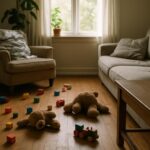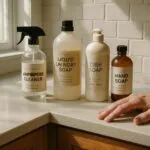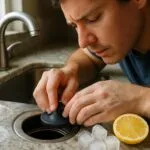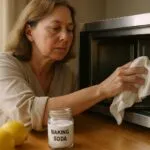High-traffic areas in a home, such as hallways and entryways, can quickly become messy and stained. Dirty carpet fibers and contaminated surfaces not only look bad but pose risks to family health too.
Cleaning high-traffic areas regularly keeps the house hygienic, extends carpet life, and helps homeowners avoid deep cleaning headaches later on.
This blog shares easy yet effective ways for cleaning high-traffic areas without harsh cleaning chemicals; in fact, over 7000 five-star reviews favor safe homemade solutions like baking soda and white vinegar.
Readers will learn simple tips for carpet care, quick stain removal methods using everyday household items, plus best practices for tile or hardwood floors. Read further to discover how small changes make big improvements in busy parts of the home.
Key Takeaways
- Regular sweeping, vacuuming, and disinfecting of high-use spaces like entryways, kitchens, and staircases boost family health by reducing germs. Daily floor care prevents dirt buildup that can cause slips or illnesses.
- Carpets in busy areas need special care to prevent stubborn set-in stains; quick DIY fixes help. A baking soda paste (3 parts baking soda to 1 part water) lifts mud and ketchup marks when left for 20 minutes before vacuuming.
- Entryways face heavy foot traffic daily: placing sturdy indoor-outdoor mats blocks tracked-in grime. Vacuum carpets twice weekly with HEPA-filter vacuums this stops allergens from collecting in carpet fibers.
- Staircase cleaning matters for safety too. Research from January 1990 July 2015 noted that cleaner stairs motivated adults toward better fitness habits; during studies, stair use rose in 72% of cases.
- Use correct cleaners based on surface material: mild soap keeps tile floors shiny without damage while diluted vinegar solutions safely clean laminate hallway floors, protecting them from moisture-related warping risks long-term.
Identifying High-Traffic Areas in Your Home
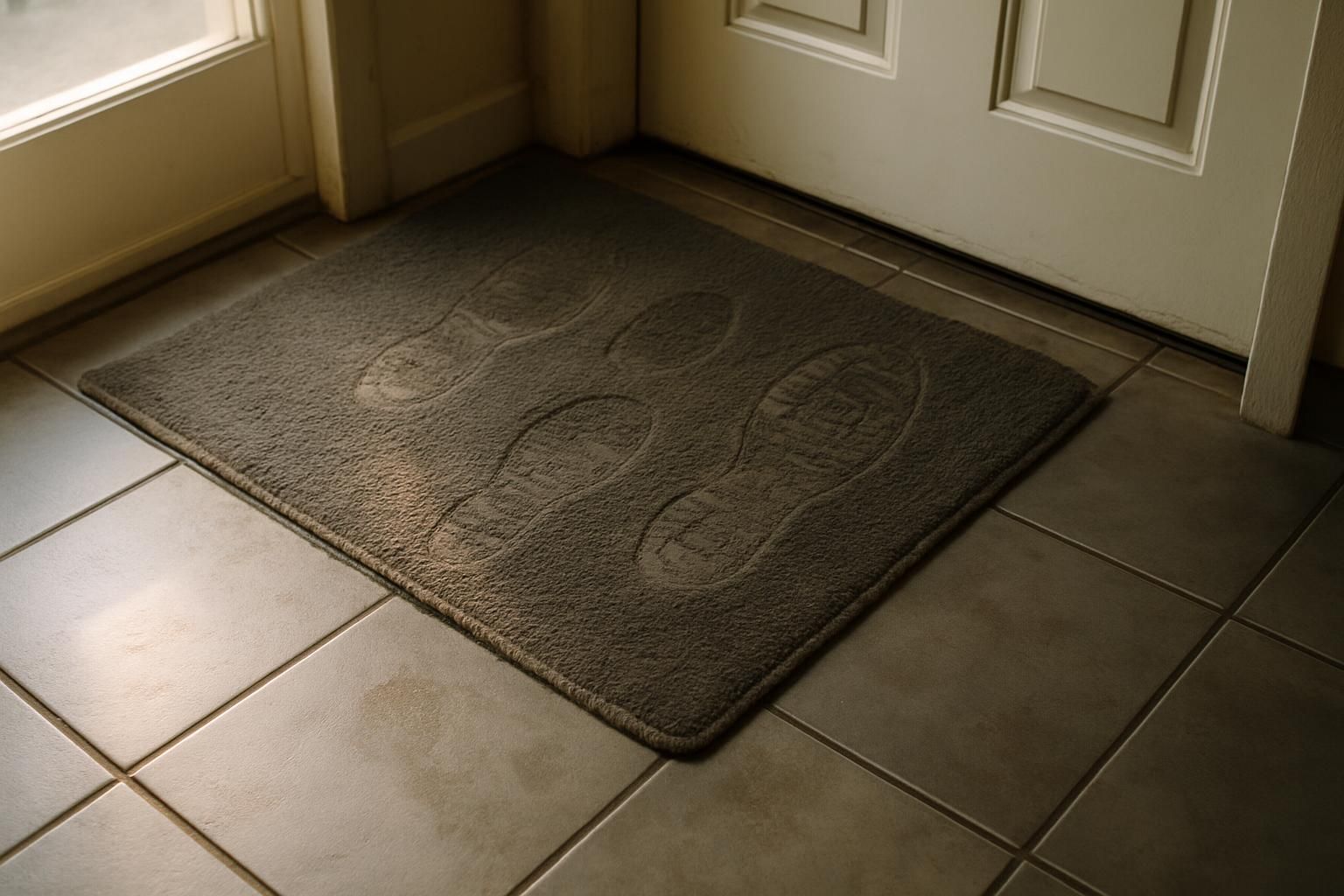
Every home has spots where the family gathers most, leaving carpets and floors dirtier and surfaces sticky like cookies. A quick glance at entryway rugs or kitchen tiles reveals exactly where foot traffic piles up.
Entryways and Hallways
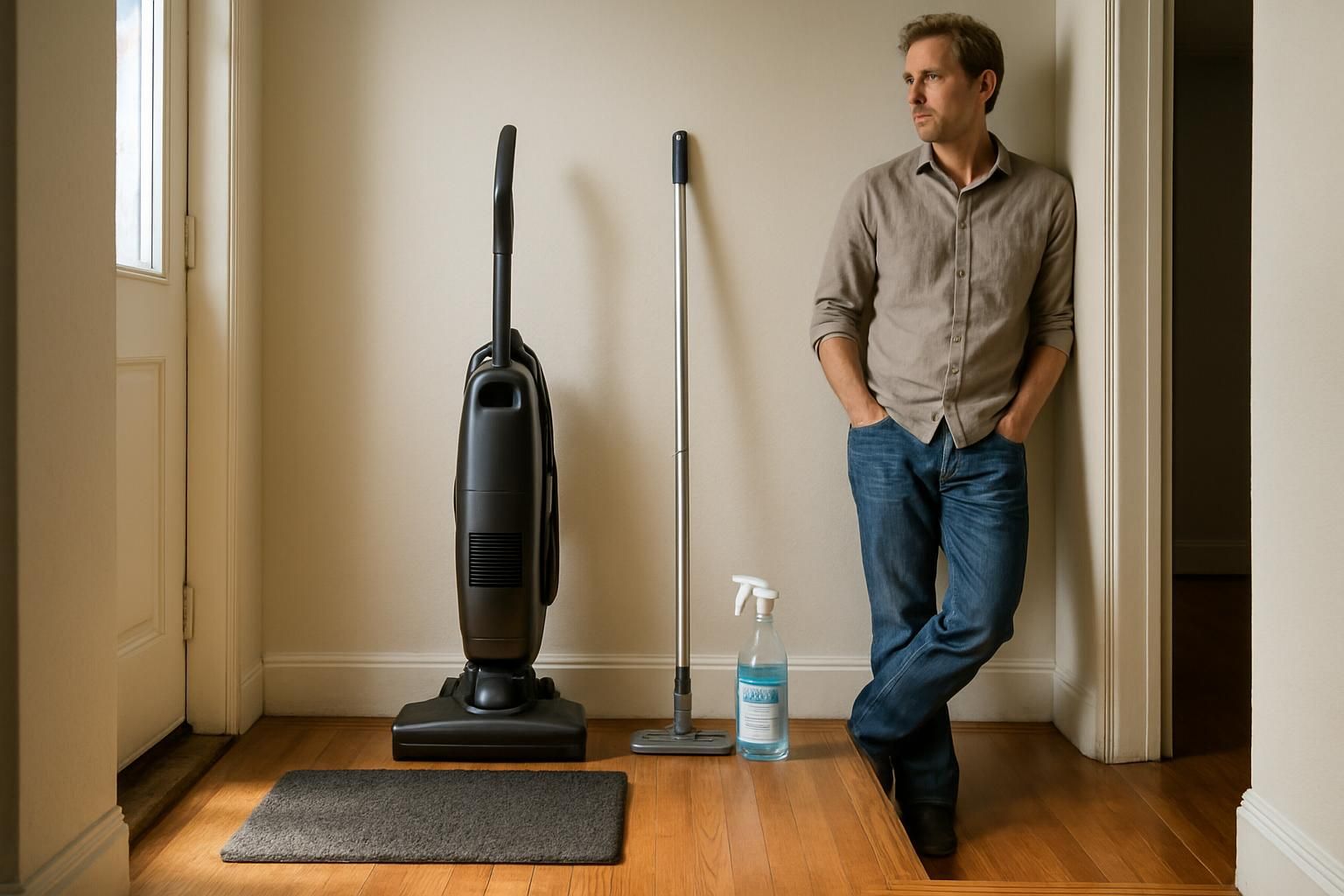
Entryways and hallways often face the worst of daily foot traffic. Placing sturdy doormats both outside and inside helps trap dirt before it reaches living spaces, making carpet cleaning easier.
Vacuum cleaners with HEPA filtration catch dust hidden in corners or near baseboards, keeping air fresh for families with kids or pets. Sweeping floors regularly stops grime from scratching hardwood surfaces; mopping weekly adds shine without harsh cleaning chemicals.
Cleaning agents designed specifically for different floor types protect carpets and tile from set-in stains caused by muddy shoes or cookie crumbs dropped by little ones. High-traffic areas stay tidy through consistent maintenance schedules that include ceilings, light fixtures, and tight hallway corners to enhance comfort at home.
Living Rooms and Common Areas
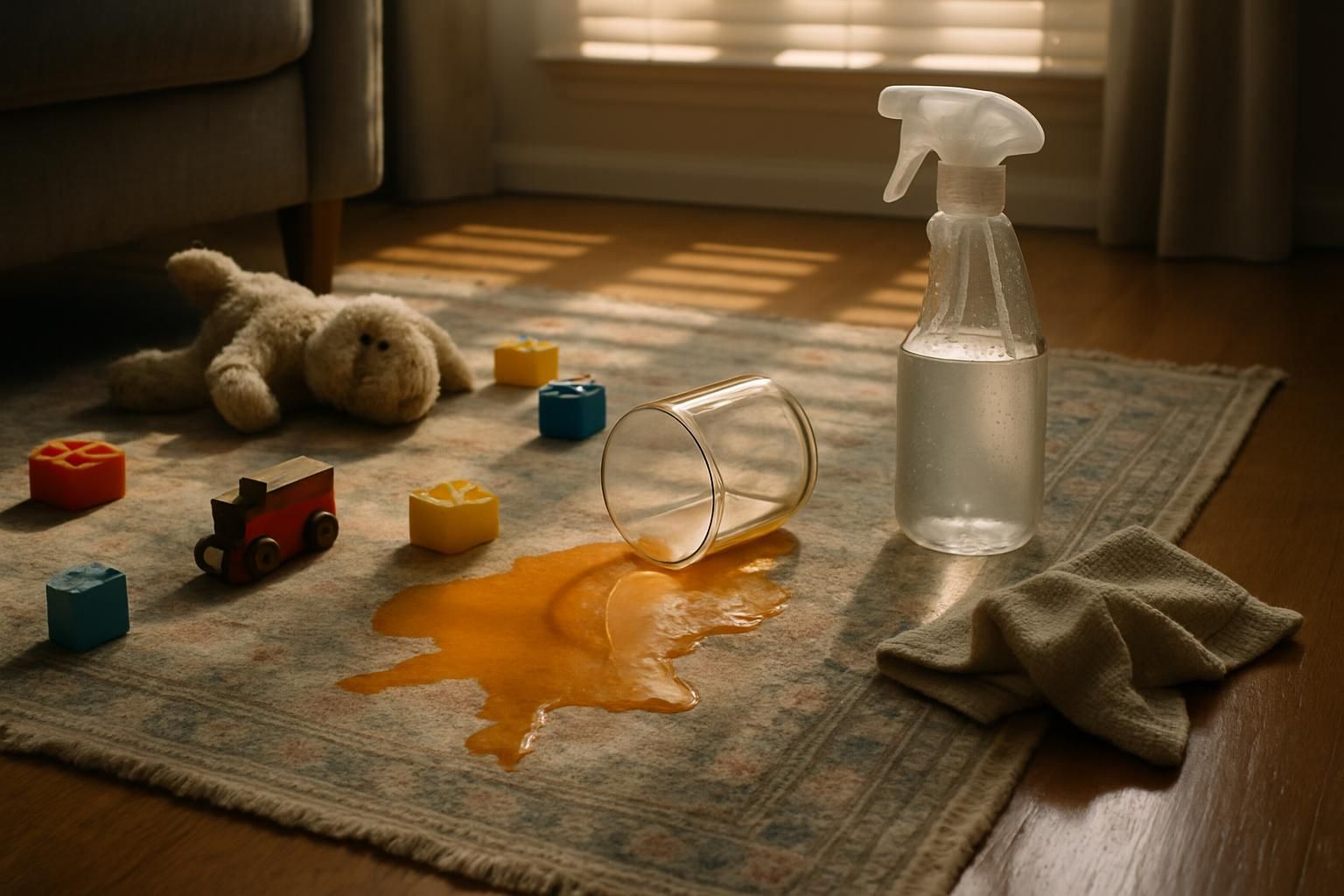
Following the busy entryways and hallways, living rooms and common areas become prime high-traffic spots in most homes. They serve as a daily gathering place for families to relax, entertain guests, or watch TV together.
Area rugs placed strategically can help protect floors from set-in stains and damaged carpet fibers. Homeowners should vacuum these spaces at least twice weekly to maintain clean carpets and reduce allergens brought in by frequent foot traffic.
Keeping cleaning supplies easily accessible lets family members quickly tackle accidental spills with appropriate cleaning products before they turn into stubborn stains.
A consistent routine maintenance plan makes deep cleaning simpler later on. Scheduling professional carpet care treatments once or twice per year refreshes floors against everyday wear caused by kids playing games or friends visiting on weekends.
Quick spot cleanups combined with regular disinfected surfaces preserve aesthetics while ensuring safety through reduced germs without relying heavily on harsh cleaning chemicals.
Kitchens and Dining Areas
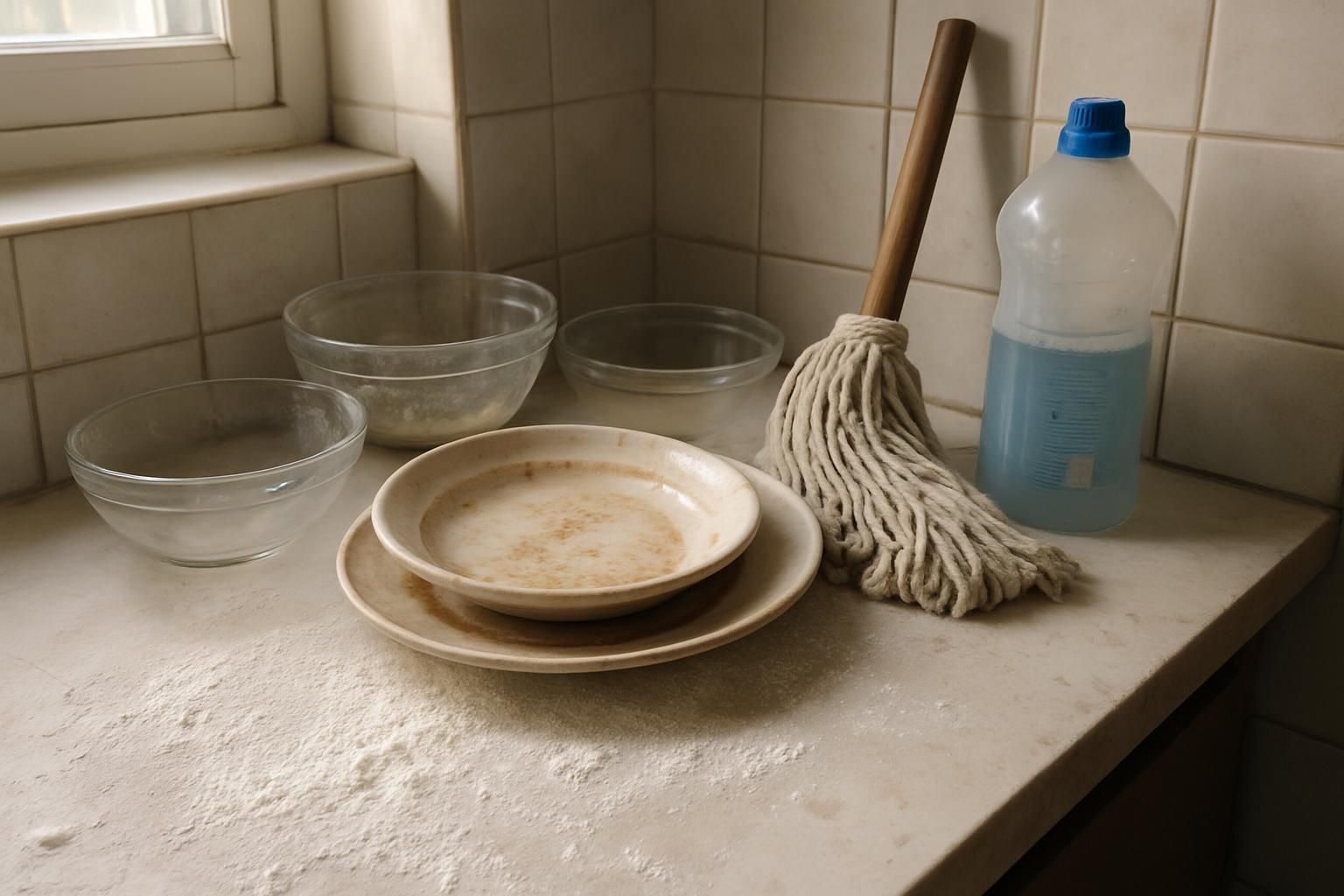
Kitchens and dining areas attract plenty of messes from cooking, eating, and family gatherings. Wiping countertops and backsplashes daily keeps germs away from food prep zones. Sweeping kitchen floors once a day removes crumbs; mopping helps tackle spills that sweeping misses.
Regular cleaning with professional cleaning products prevents set-in stains on counters and floors. Cleaning chemicals like disinfectants work well for quick sanitation after handling raw meats or messy ingredients.
Keeping kitchens hygienic matters because clean surfaces protect everyone’s health during meal preparation.
Next up are staircases, another busy area needing focused attention to remain safe and tidy.
Staircases

Staircases see constant foot traffic daily, so regular upkeep matters a lot. In fact, between January 1990 and July 2015, studies showed that clean stairways encouraged adults to stay active; during such interventions, stair use rose in 72% of cases.
Dust buildup on steps can lead to slips or falls; keeping stairs clear boosts safety for families and guests alike. Regular sweeping or vacuuming helps remove dirt tracked from shoes before it settles deep into carpet fibers.
For the occasional set-in stains caused by kids or pets, homeowners can turn to reliable DIY carpet cleaning solutions instead of expensive professional cleaning products.
The Importance of Cleaning High-Traffic Areas
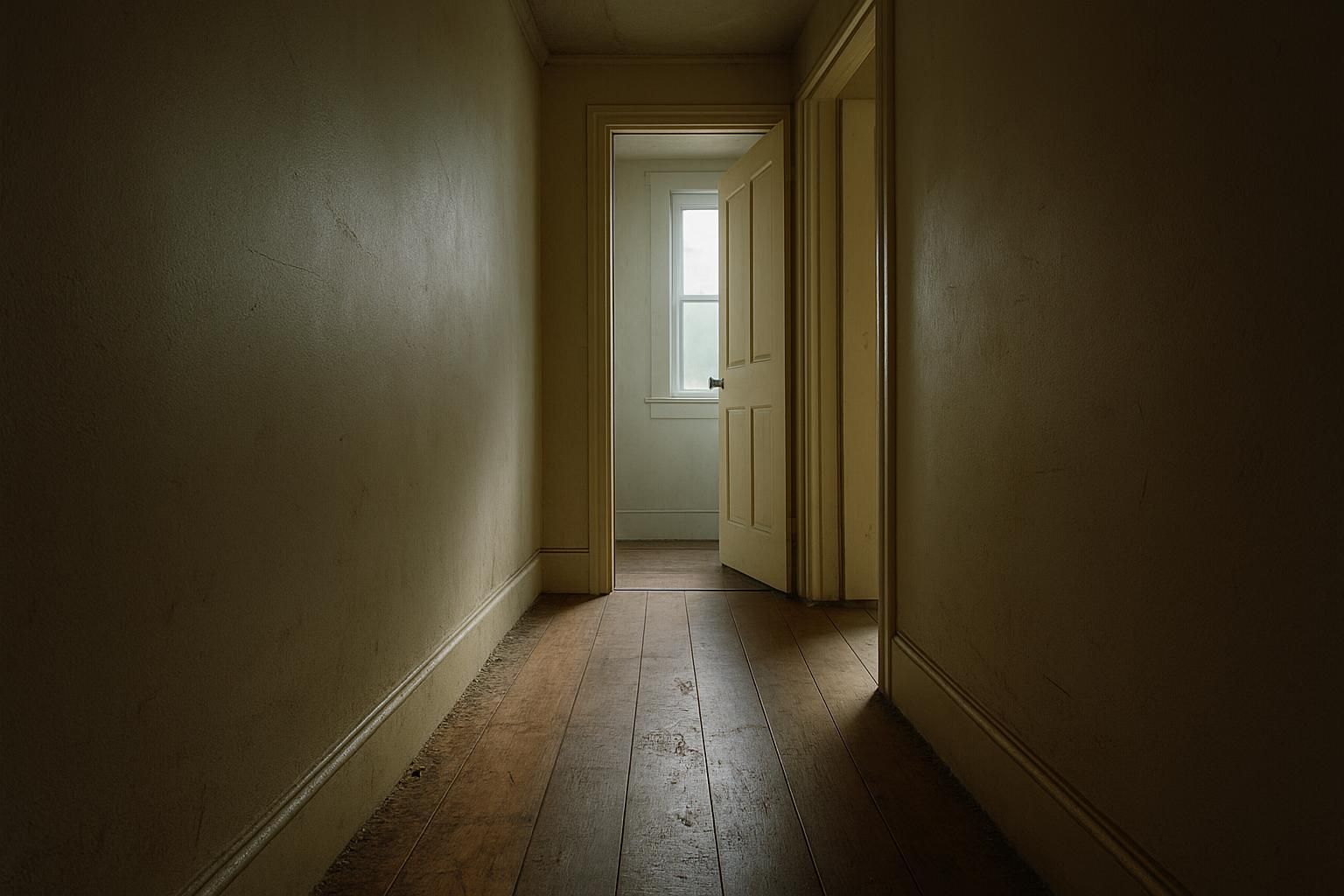
Cleaning your home’s busiest spots protects family health, saves money on repairs, and keeps guests impressed curious how it works?
Maintaining Hygiene and Health
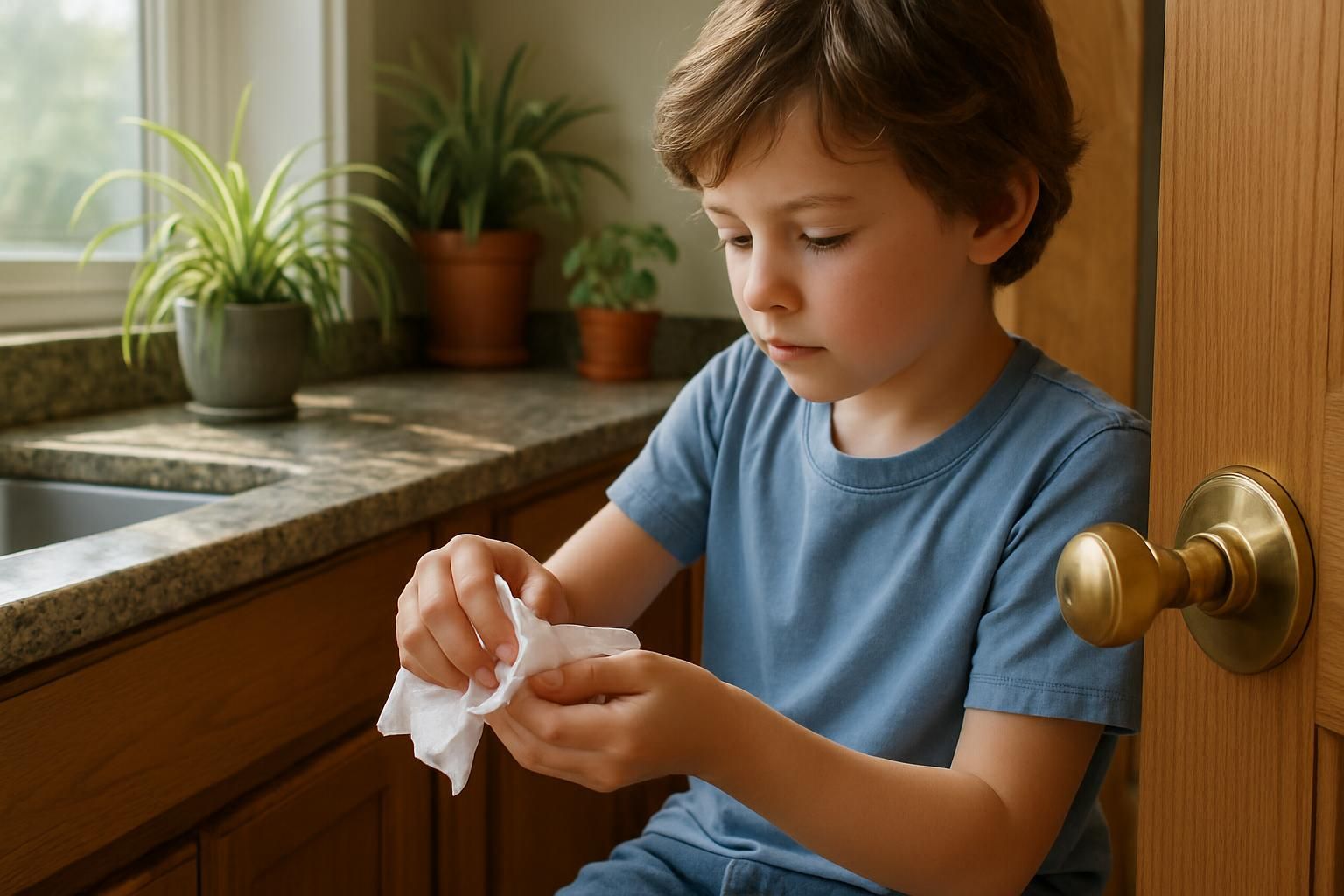
High-traffic areas like kitchens, entryways, and living rooms often become hotspots for germs. Regular sweeping, vacuuming, and disinfecting these places reduces germ spread significantly.
Using professional cleaning products or simple DIY solutions helps keep carpet fibers clean from set-in stains that bacteria might favor. Households using hand sanitizer in common spots like entry halls help stop germ transfer from outside devices such as mobile phones or tablets.
A deep-cleaned space not only protects a family’s health but also makes surfaces safer to use day to day.
Reducing grime and dirt build-up in popular household spaces contributes directly to public health inside the home. Cleaner floors mean fewer chances of slips or falls for family members—especially kids running around daily! Germ-free zones like kitchens reduce risks of food-related sicknesses too, helping households stay healthy year-round without frequent doctor visits linked with common illnesses.
Maintaining hygiene through consistent cleaning habits and regular disinfecting practices, including wiping down doorknobs or countertops frequently touched by everyone, supports long-term surface durability as well.
Prolonging Surface Durability
Keeping surfaces clean does more than protect family health; it also prevents excessive wear and tear. Daily sweeping and mopping help remove dirt before particles settle deeply into carpet fibers or scratch hard floor finishes.
Spot-cleaning spills immediately with professional cleaning products reduces the chance of permanent set-in stains. Consistent carpet maintenance in living rooms, kitchens, entryways, and staircases cuts down on future costly replacements by extending floor life.
Regular deep cleaning practices, including periodic use of suitable cleaning chemicals for carpets or hardwood floors, keep indoor surfaces in tip-top shape even in busy high-traffic areas.
Enhancing Home Aesthetics
Along with durability, regular cleaning of high-traffic areas boosts home aesthetics. Clean carpets without set-in stains brighten rooms and add visual harmony to living spaces. Bright hallways and entryways give visitors a pleasant impression right from the doorstep.
Carpet maintenance, including occasional deep cleaning with professional cleaning products, keeps carpet fibers vibrant and fresh-looking.
Wiping down tiles in kitchens or polishing hardwood floors regularly brings out the natural beauty of these surfaces. Areas free from dirt buildup enhance overall room appeal; even simple tasks like spot-cleaning spills promptly help maintain attractive flooring longer.
Having sparkling staircases and shiny floors throughout common areas makes any house feel welcoming, cozy and cared-for.
Effective Cleaning Strategies

Tackling dirt in high-traffic areas means using the right cleaning chemicals and tools, with a bit of elbow grease to boot. Quick action on spills, regular vacuuming sessions, and choosing surface-friendly professional cleaning products make home upkeep easier.
Regular Sweeping and Vacuuming
Regular sweeping and vacuuming keep high-traffic areas free from dirt. It protects surfaces from damage, giving homes a fresh look.
- Sweep entryways and hallways daily to remove dirt and debris carried inside by shoes, bags, or pets.
- Vacuum carpets in living rooms and common areas at least 2-4 times a week; this protects carpet fibers, keeping colors bright and material strong.
- Use vacuum attachments to focus on corners and edges, areas where dust collects frequently.
- Select appropriate equipment for different flooring types; use vacuums with gentle brushes for hardwood floors and stronger bristles for carpet cleaning in high-traffic areas.
- Regularly empty vacuum containers or replace bags before they fill up completely; full containers reduce suction power needed for deep cleaning.
- Check beneath furniture weekly since objects under couches or tables can block airflow, making vacuums less effective in removing set-in stains or hidden particles.
- Maintain vacuum filters by cleaning or replacing them monthly; clogged filters reduce cleaning effectiveness on carpets that see heavy use.
- Choose professional cleaning products labeled safe around children and pets instead of harsh chemicals that leave residues after routine cleaning.
- Avoid skipping scheduled vacuum days even if floors appear clean; many tiny particles hide in carpets until layers accumulate, causing allergens or wear.
- Sweep kitchen floors thoroughly each evening after meals to remove crumbs, helping to prevent pests and maintain hygiene.
Spot Cleaning for Stains and Spills
Sweeping and vacuuming remove dust and dirt, but some messes require extra attention. Spot cleaning quickly tackles stains before they turn into set-in stains on carpets or floors.
- Quickly blot fresh spills with a clean cloth to absorb liquids; rubbing can push the stain deeper into carpet fibers.
- Apply a homemade mixture of vinegar and baking soda as a natural stain remover; let the paste sit for 10 minutes, then rinse with cold water for effective carpet maintenance.
- Avoid leaving spots unattended overnight; prompt action helps prevent stain setting that may require professional intervention later.
- Test any deep cleaning chemicals first in a hidden spot; some cleaners can discolor carpets or hard surfaces.
- For muddy shoe prints on tile floors or hardwood surfaces, lightly dampen a mop with warm water mixed with mild detergent to lift dirt without harming finishes.
- Teach household members, especially kids, simple cleanup steps to reduce lasting damage from spills.
- Keep microfiber cloths, spray bottles with stain solution, and disposable wipes near kitchens or living areas for swift accident management.
- Tackle food-related spills promptly during meal preparation; grease or sauce stains can become permanent if left untreated.
- Establish house rules about eating away from designated areas to lower the frequency of challenging stains.
- If carpet staining persists despite careful spot cleaning, homeowners should consult trusted professional carpet care services for expert assistance.
Using Appropriate Cleaning Products for Different Surfaces
Choosing the right cleaning products keeps high-traffic areas safe and protected. Some surfaces handle cleaners better than others, so careful selection matters.
- Tile and sealed wood floors remain cleaner with mild soap solutions; harsh cleaning chemicals can dull finishes and weaken surfaces.
- Carpet fibers in busy areas like living rooms or entryways benefit from gentle carpet cleaning sprays or DIY vinegar mixtures to address set-in stains without damage.
- Stone surfaces, such as granite counters or marble tiles in kitchens and dining areas, do best with pH-balanced gentle cleansers instead of acidic agents.
- Stainless steel appliances in kitchens respond well to microfiber cloths dampened with water or specialized stainless steel cleaners rather than abrasive sponges.
- Glass tabletops and windows shine using streak-free glass cleaner formulas applied with lint-free microfiber cloths.
- Frequently touched items like doorknobs, handles, switches, and tablets benefit from regular disinfection with non-toxic sanitizing wipes.
- Plastic toys or children’s play tables require mild soap diluted in water rather than strong chemical cleaners to avoid unnecessary exposure.
- Upholstered furniture fabric fares best with professional cleaning products made specifically for fabric care; these products clean effectively without causing color fade.
- Laminate flooring in hallways holds up better when cleaned with diluted white vinegar solutions instead of harsh detergents that may cause warping.
- Wooden stairway rails maintain their smooth feel and look longer if polished occasionally with beeswax paste rather than chemical sprays dense with artificial fragrances.
Disinfecting High-Touch Surfaces
Disinfecting high-touch surfaces is essential in high-traffic areas where items are frequently handled. Using appropriate professional cleaning products matters, and regular disinfection helps reduce germ spread.
- Disinfect doorknobs touched daily by both kids and adults using approved cleaning chemicals.
- Regularly wipe light switches with mild bleach solutions or cleaners containing 70% alcohol.
- Carefully clean electronic devices such as remotes and tablets with a cloth lightly dipped in alcohol-based cleaners to prevent virus transfer.
- Toilet seats require daily disinfection using safe yet strong cleaning chemicals meant for bathrooms.
- Clean tables and countertops in kitchens or dining areas daily with solutions like diluted bleach to remove pathogens.
- Kitchen appliance handles should receive a quick wipe with household disinfectants to reduce contamination risks.
- Maintain privacy settings on personal devices during online ordering of cleaning supplies to prevent data sharing.
- Include carpet maintenance in routine disinfection, especially near entryways where tracked-in dirt can harbor germs.
Special Considerations for Carpets in High-Traffic Areas
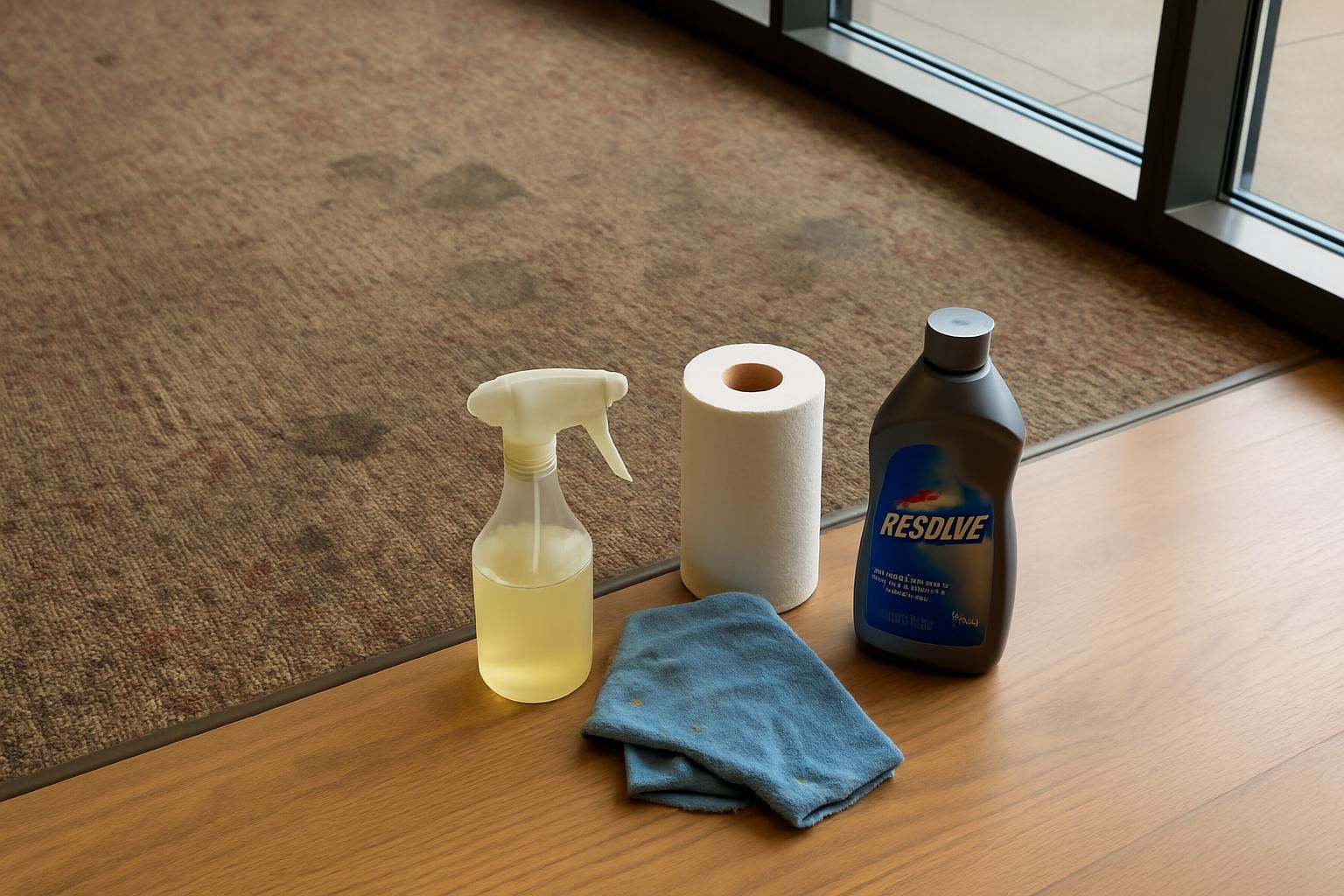
Carpets in busy spaces need extra care to fight set-in stains and protect carpet fibers—learn how simple DIY cleaning tricks and professional cleaning products can save your floor.
How to Remove Stubborn Stains
Stubborn stains can frustrate even the calmest homeowner. Quick action and the right tools will make carpet maintenance easier.
- Blot spills gently with a clean, white cloth or paper towel; rubbing pushes the stain deeper into carpet fibers.
- Spread a paste made from equal parts baking soda and white vinegar on tough stains like coffee or juice; wait about 10 minutes before wiping up.
- Mix mild dish soap with warm water to create an effective homemade carpet cleaning solution using approximately one teaspoon of soap per cup of water.
- Always test professional cleaning products on a hidden area first, as harsh cleaning chemicals may damage delicate fabrics or dye colors.
- Use a soft brush to gently loosen dried mud, then vacuum to lift away loosened particles without harming the carpet.
- Lightly apply cornstarch to greasy spots to absorb oils, let it rest for about 20 minutes, then vacuum; repeat if necessary until the stain lifts.
- For grape juice or wine spills, pour club soda directly onto the stained area; allow bubbles to work before blotting dry with a clean towel.
- Dab hydrogen peroxide diluted with water (one part peroxide to two parts water) onto bloodstains and blot promptly.
- For crayon marks, place brown paper over the marks and use a low-heat iron to draw the wax out without damaging the carpet.
- Keep these DIY tips handy for quick touch-ups between scheduled professional carpet care appointments.
DIY Carpet Cleaning Solutions
Spills in high-traffic areas can cause set-in stains on carpets. Immediate treatment helps maintain carpet fibers and prolong overall carpet care.
- For common spills such as juice or coffee, mix equal amounts of vinegar and water in a spray bottle. Spray onto the stain, let it sit for two minutes, then blot with a clean towel; repeat until the stain fades.
- Tougher stains like mud or ketchup benefit from a baking soda paste made by mixing three parts baking soda with one part water. Spread the paste over the stain, allow it to dry for about 20 minutes, then vacuum thoroughly.
- For pet accidents, sprinkle baking soda on fresh messes to absorb moisture and odors. Let it sit for at least 15 minutes before vacuuming.
- To tackle greasy stains from cooking oil, mix two teaspoons of mild dish soap in two cups of warm water. Dampen a cloth with this mixture and gently dab the stain until it is removed; rinse with cold water afterward.
- For dried chewing gum, wrap ice cubes in a plastic bag and place it on the gum for about four minutes until it hardens enough to peel away from the carpet fibers.
- For ink spills, apply rubbing alcohol on a clean white cloth and blot the inked area carefully; avoid rubbing aggressively to prevent deeper penetration.
- In addition to homemade cleaners, professional cleaning products approved for deep cleaning carpets offer powerful options against stubborn dirt in high-traffic areas.
Preventative Measures for Carpet Longevity
After treating stains with DIY carpet cleaning solutions, protecting carpets from heavy use is essential. High-traffic areas require added care, but smart habits help boost carpet longevity.
- Enforce a strict no-shoe policy at entryways and hallways since shoes bring dirt and germs that damage carpet fibers.
- Vacuum high-traffic areas at least twice weekly to remove dirt before it sets in.
- Place sturdy doormats near entrances to catch dirt before it reaches carpets.
- Add area rugs in busy spaces like living rooms and dining areas to absorb daily wear; rugs are easier and cheaper to replace.
- Rotate furniture every few months in common areas to prevent continuous wear on specific carpet areas.
- Blot spills immediately with a microfiber cloth rather than rubbing, which can embed set-in stains.
- Schedule professional carpet cleaning every 12–18 months to remove deeply embedded dirt and allergens.
- Use specialized stain-repellent sprays to act as a barrier against future spills.
- Trim pet nails regularly to avoid snags and pulls in the carpet fibers.
- Keep spot-treatment supplies nearby to address any messes promptly.
Tips for Cleaning Hard Floors in High-Traffic Areas

Hardwood floors can lose shine if dirt gets tracked in daily. Families who use mats or rugs at entrances often reduce cleaning time drastically.
Best Practices for Tile and Hardwood Floors
Tile and hardwood floors in high-traffic areas can get scratched or stained. Homeowners can follow these practical tips to keep surfaces clean, attractive, and safe:
- Place protective mats and rugs at entryways to absorb footsteps, trap dirt, and reduce wear on flooring; use mats with non-slip backing to prevent slips.
- Sweep tile and hardwood floors daily to remove grit and debris that scratch surfaces.
- Vacuum once or twice weekly using a vacuum setting suitable for hard floors to capture dust between tiles and protect wood finishes.
- Mop tile floors with warm water mixed with cleaning chemicals formulated for tile; avoid harsh cleaners that damage grout lines.
- Use microfiber mops dampened lightly for hardwood floors; avoid excess water to prevent warping of wood planks.
- Perform spot cleaning promptly whenever stains occur; set-in stains may permanently damage floor finishes if not treated.
- Avoid abrasive scrubbing tools on hardwood or tile floors, as they can remove protective sealants.
- Cushion furniture with soft pads to prevent scratches from movement.
- Refinish hardwood floors every five years or sooner depending on use to restore protection and appearance.
- Polish tile surfaces periodically with a streak-free polishing agent to restore lost shine from friction.
Following simple steps such as daily sweeping combined with protective measures ensures long-term benefits. Maintaining hygiene, promoting safety around children’s play zones, and extending the life of floors are all achievable in busy family environments.
Using Protective Mats and Rugs
Entryways, kitchens, and busy halls often bear the brunt of daily foot traffic. Protective mats and rugs keep these areas clean while adding warmth and style.
- Place rugs or runners at entry points to trap dirt and moisture from shoes. Mats minimize the spread of grime inside the home.
- Select mats with non-slip backings for areas like hallways or kitchens to lower the risk of slips.
- Install durable carpet runners along staircases to protect carpet fibers from excessive wear caused by constant use.
- Vacuum mats in high-traffic areas at least twice weekly to remove debris before it settles and causes set-in stains.
- Choose washable rugs for dining or play areas where spills are common to quickly address accidents without needing professional cleaning products.
- Use sturdy rubber-backed kitchen mats near sinks, stoves, or preparation areas to protect floors against water damage and stains.
- Regularly check if area rugs require a deep cleaning to remove trapped dirt that could damage underlying floors.
- Rotate protective mats seasonally so they wear evenly under constant foot traffic.
- Allow freshly cleaned mats to dry completely before replacing them to avoid moisture damage.
- Placing doormats both outside and inside doorways provides double-layer protection against dirt being tracked indoors.
Regular Polishing and Sealing
Regular polishing and sealing give hard floors extra protection. These methods help prevent wear and keep surfaces looking fresh.
- Polish hardwood floors to add shine and create a protective layer against dirt and scratches, especially at entryways and hallways.
- Seal tile floors annually to guard grout lines against moisture, stains, and grime buildup.
- Use high-quality cleaning chemicals made for floor sealing to achieve long-lasting results on wood or tiled surfaces.
- Daily sweeping or vacuuming removes loose debris that can scratch polished finishes.
- Sealing hard floors helps avoid issues common with carpets, where set-in stains are more likely.
- Regular maintenance helps reduce replacement costs by extending the life of floors.
- Commercial sealants protect against water damage from spills, benefiting family homes with young children.
- Routine polishing can reduce bacteria and promote hygiene in busy kitchens or dining areas.
- Floor polishers offer an affordable way to restore shine after regular cleaning sessions.
- Apply sealant every 6-12 months to maintain protection on high-traffic floors.
Developing a Consistent Cleaning Routine
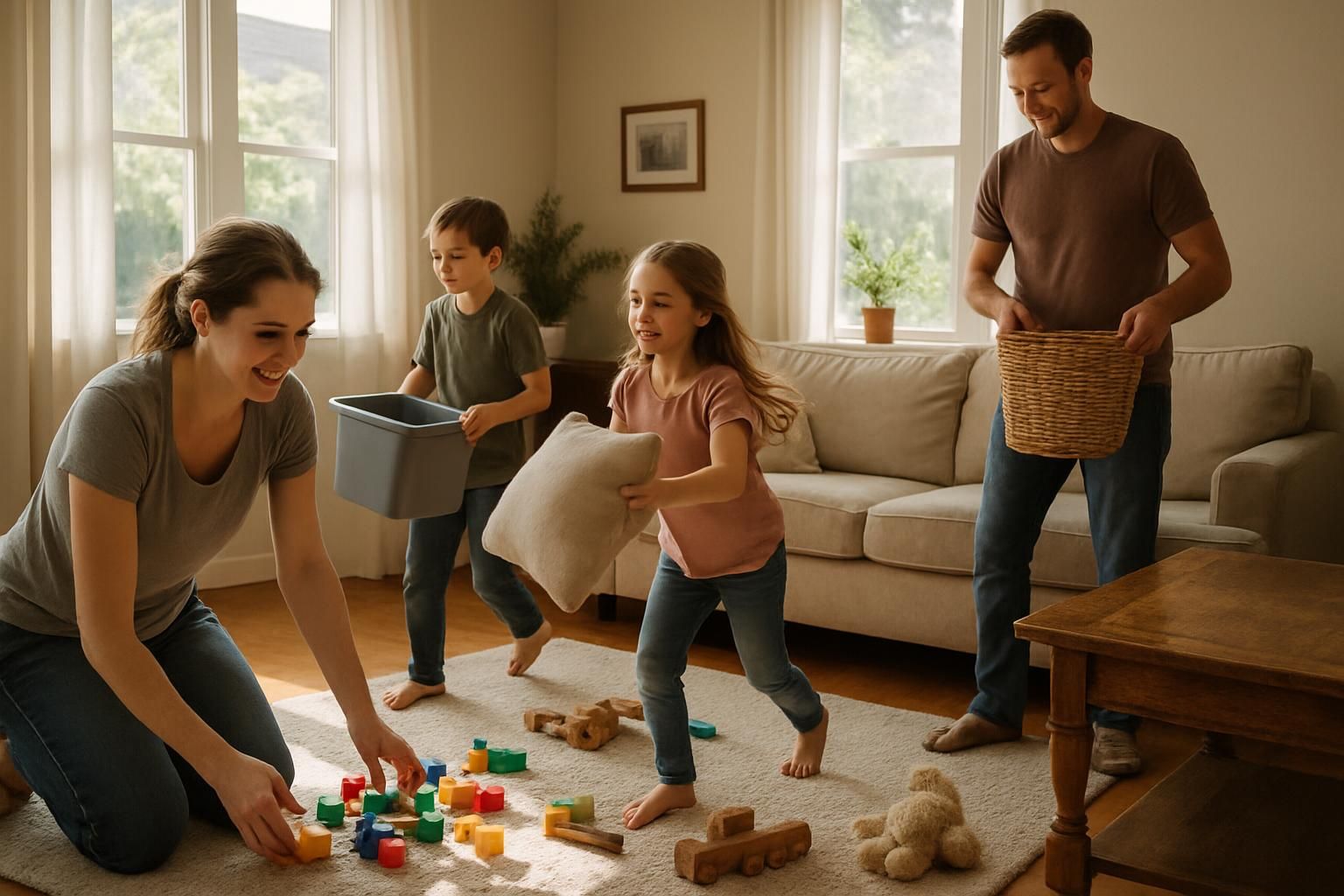
Creating a simple routine cuts cleaning stress and makes busy areas sparkle without endless effort. Turning chores into family team time means less hassle and fewer sighs from the kids.
Creating a Cleaning Schedule
High-traffic areas benefit from a clear schedule. A realistic plan cuts cleaning time and prevents stress.
- Households that tailor schedules to their lifestyles achieve better results. Homes with young kids might need daily carpet maintenance to prevent set-in stains.
- Everyone in the home should know their daily or weekly tasks. Posting a calendar on the fridge or a family bulletin board helps keep chores visible.
- Prioritize high-traffic areas by setting specific days for cleaning kitchens, hallways, entryways, staircases, and family rooms.
- Regular habits improve cleaning effectiveness over time. Vacuuming carpet fibers twice a week prevents stubborn dirt buildup.
- Schedule hard floor cleaning at set times. For example, mop tile floors every Sunday afternoon using mild cleaners safe for children and pets.
- Time management apps can streamline cleaning reminders across devices.
- Keep containers near doorways to store shoes, backpacks, and jackets instead of leaving them on the floor.
- High-touch surfaces such as doorknobs, railings, and countertops should be wiped down at least three times weekly with disinfectants.
- Adjust the schedule during busy times like holidays or school weeks to remain practical.
- Involve all family members in maintaining household cleanliness to share the workload.
- Review and refine the cleaning routine periodically to ensure it meets the home’s needs.
- Invest in useful tools such as ergonomic mops with washable microfiber pads or lightweight cordless vacuums to simplify daily tasks.
- Plan periodic deep-cleaning days every one to two months to complement shorter daily sessions.
Tools and Equipment to Streamline Cleaning
Once a cleaning schedule is in place, the right tools speed up tasks. Modern supplies help clean high-traffic areas faster and more efficiently.
- Microfiber cloths capture dirt and moisture quickly without spreading mess.
- HEPA vacuum cleaners trap dust, allergens, pet dander, and even tiny carpet fibers effectively.
- A cleaning caddy keeps all supplies organized in one easy-to-carry container.
- Squeegees produce streak-free surfaces on windows, mirrors, or glossy tiles.
- Compact cordless handheld vacuums handle quick spot-cleaning on small spills near entryways and staircases.
- Spray mops with refillable solutions offer fast cleanup for minor spills on hard floors.
- Extendable dusters reach high areas like ceilings and crown moldings without the need for ladders.
- Disposable disinfecting wipes quickly sanitize high-touch items such as door handles and remote controls.
- Automated robot vacuums can maintain daily cleanliness on both hard floors and low-pile carpets.
- Floor polishers help restore shine on hardwood floors after regular sweeping and vacuuming.
Involving the Whole Family
Everyone can share the effort of keeping high-traffic areas clean. Assigning specific tasks to each member maintains household order and builds a team spirit.
Turning cleaning into a fun activity can encourage regular participation. Families may time small tasks or create friendly challenges during sweeping sessions.
Engaging everyone in minor chores helps develop effective cleaning habits without adding stress.
Safety and Eco-Friendly Practices
This section offers additional tips for safety and environmentally friendly cleaning. The strategies described are based on best practices for using professional cleaning products and handling cleaning chemicals responsibly.
- Always read and follow the instructions on cleaning chemical labels to avoid hazards. Use protective gloves when handling strong cleaning products.
- Ensure proper ventilation in rooms when using cleaning chemicals to reduce inhalation of fumes.
- Consider eco-friendly cleaning formulations that reduce environmental impact while effectively managing carpet maintenance and set-in stains.
- Avoid mixing different cleaning chemicals to prevent the formation of harmful compounds.
- Review your cleaning schedule periodically and adjust procedures based on the intensity of high-traffic areas.
Conclusion
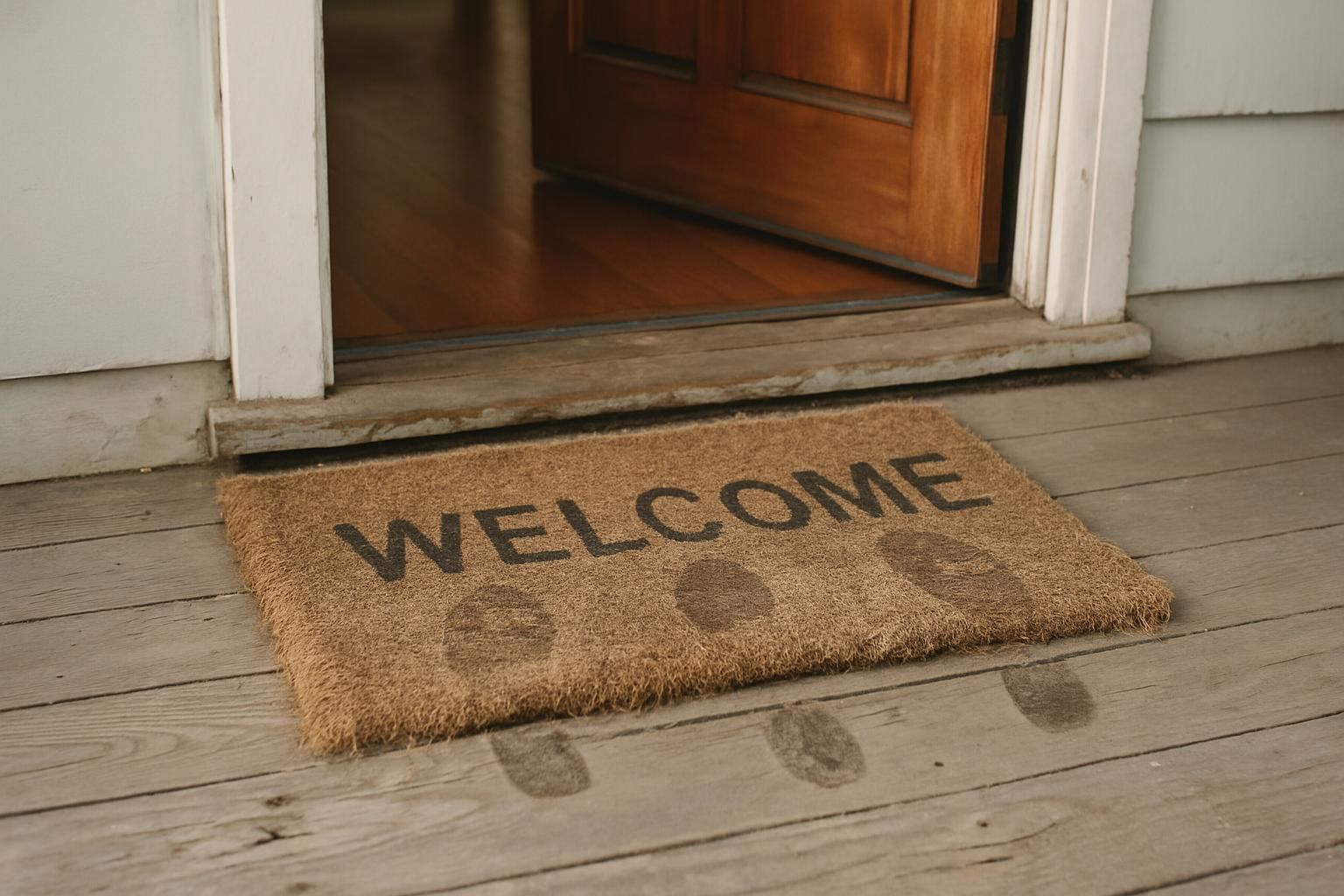
Keeping high-traffic areas clean takes some planning, smart products, and steady habits. Regular vacuuming, spot-cleaning with homemade vinegar solutions, and using mats can help these busy spaces stay spotless.
Households benefit by using non-harsh cleaning chemicals; safe natural recipes work well for kids and pets. Building a steady cleaning schedule saves headaches later on. A tidier home looks better, lasts longer, and gives everyone more reasons to smile amid chaos!
FAQs
1. What cleaning methods work best for high-traffic areas in my home?
High-traffic spots like hallways and entryways need frequent vacuuming or sweeping to remove dirt buildup. Using a durable mat at entrances traps grime before it spreads further into the home.
2. How often should I clean busy household spaces?
Aim to tidy up heavy-use zones every two days; regular upkeep prevents stubborn set-in stains. A quick daily sweep can also save extra effort later.
3. Are there special products that help tackle tough dirt in crowded rooms?
Yes, choose cleaners suited for carpets or hardwood floors depending on the surface. For carpeted areas, spot removers quickly lift spills without harming fibers; wood-safe sprays keep flooring shiny without leaving slippery residues.
4. Can I reduce how dirty these popular spaces get each day?
Absolutely! Encourage guests and family members to remove shoes when entering. Placing a shoe rack near doorways helps lower the amount of dirt tracked inside along with effective carpet cleaning methods.


